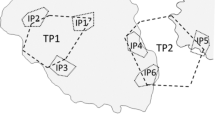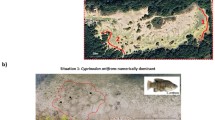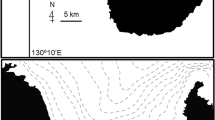Abstract
Territoriality fundamentally influences animal mating systems and patterns of population structure. Although territory ownership is already known to contribute importantly to male reproductive success and the ecological coexistence of African rock-dwelling cichlids, the significance of variation in territory features has received little attention in these fishes. In Lake Malawi, males of Pseudotropheus tropheops “orange chest” defend territories on either of two substrate classes at Harbour Island: flat rock slabs lacking crevices and caves, or structurally complex boulder fields containing cave shelters. Focal watches of this species demonstrated that both territory size and occupancy on either substrate type depend on the size of male residents. Males larger than a threshold size exclusively held the largest and most structurally complex territories. After removal of conspecific residents, more vacant territorial areas on cave-containing substrate were reoccupied by “orange chest” males in full breeding coloration compared to vacant areas on flat substrate. These findings suggest competition among “orange chest” males for complex rocky substrate. Defense of caves was associated with enhanced male courtship rates: the number of caves within a male’s territory was a better predictor of courtship activity than was male size or territory area. In addition to territories being crucial for male reproductive success and therefore likely playing a role in sexual selection, male–male competition for caves in rock-dwelling cichlids may be promoted by the ecological advantage of enemy-free space. Smaller “orange chest” males lacking caves tended to move into adjacent boulder fields in the presence of predators, particularly at night. In contrast, males defending caves were more likely to remain on their territories when nocturnal predators were present. The territorial behaviors of P. tropheops “orange chest” that we observed in situ provide an instructive natural framework for testing the roles of substrate and ecology in the mating systems of rock-dwelling cichlid fishes.



Similar content being viewed by others
References
Adams ES (2001) Approaches to the study of territory size and shape. Annu Rev Ecol Syst 32:277–303
Andersson M (1994) Sexual selection. Princeton University Press, Princeton, NJ
Arnegard ME, Carlson BA (2005) Electric organ discharge patterns during group hunting by a mormyrid fish. Proc R Soc B 272:1305–1314
Arnegard ME, Kondrashov AS (2004) Sympatric speciation by sexual selection alone is unlikely. Evolution 58:222–237
Arnegard ME, Markert JA, Danley PD, Stauffer JR Jr, Ambali AJ, Kocher TD (1999) Population structure and colour variation of the cichlid fish Labeotropheus fuelleborni Ahl along a recently formed archipelago of rocky habitat patches in southern Lake Malawi. Proc R Soc Lond B 266:119–130
Baerends GP, Baerends-van Roon JM (1950) An introduction to the study of the ethology of cichlid fishes. Behav Suppl 1:1–235
Benjamini Y, Hochberg Y (1995) Controlling the false discovery rate: a practical and powerful approach to multiple testing. J R Stat Soc B 57:289–300
Calsbeek R, Sinervo B (2002a) An experimental test of the ideal despotic distribution. J Anim Ecol 71:513–523
Calsbeek R, Sinervo B (2002b) The ontogeny of territoriality during maturation. Oecologia 132:468–477
Couldridge VCK, Alexander GJ (2002) Color patterns and species recognition in four closely related species of Lake Malawi cichlid. Behav Ecol 13:59–64
Dijkstra PD, Seehausen O, Groothuis TGG (2005) Direct male–male competition can facilitate invasion of new colour types in Lake Victoria cichlids. Behav Ecol Sociobiol 58:136–143
Duftner N, Sefc KM, Koblmüller S, Nevado B, Verheyen E, Phiri H, Sturmbauer C (2006) Distinct population structure in a phenotypically homogeneous rock-dwelling cichlid fish from Lake Tanganyika. Mol Ecol 15:2381–2395
Egger B, Meekan M, Salzburger W, Mwape L, Makasa L, Shapola R, Sturmbauer C (2004) Validation of the periodicity of increment formation in the otoliths of a cichlid fish from Lake Tanganyika, East Africa. J Fish Biol 64:1272–1284
Emlen ST, Oring LW (1977) Ecology, sexual selection, and the evolution of animal mating systems. Science 197:215–223
Fricke HW (1986) Pair swimming and mutual partner guarding in monogamous butterflyfish (Pisces, Chaetodontidae): a joint advertisement for territory. Ethology 73:307–333
Fryer G (1959) The trophic interrelationships and ecology of some littoral communities of Lake Nyasa with especial reference to the fishes, and a discussion of the evolution of a group of rock-frequenting Cichlidae. Proc Zool Soc Lond 132:153–281
García LV (2004) Escaping the Bonferroni iron claw in ecological studies. Oikos 105:657–663
Genner MJ, Turner GF (2005) The mbuna cichlids of Lake Malawi: a model for rapid speciation and adaptive radiation. Fish Fish 6:1–34
Genner MJ, Turner GF, Hawkins SJ (1999) Resource control by territorial male cichlid fish in Lake Malawi. J Anim Ecol 68:522–529
Hert E (1990) Factors in habitat partitioning in Pseudotropheus aurora (Pisces: Cichlidae), an introduced species to a species-rich community of Lake Malawi. J Fish Biol 36:853–865
Hert E (1992) Homing and home-site fidelity in rock-dwelling cichlids (Pisces: Teleostei) of Lake Malawi, Africa. Environ Biol Fish 33:229–237
Hert E (1995) The impact of intralacustrine introductions with regard to space utilization and competition for territories to a cichlid fish community in Lake Malawi, Africa. Ecol Res 10:117–124
Hofmann HA, Benson ME, Fernald RD (1999) Social status regulates growth rate: consequences for life-history strategies. Proc Nat Acad Sci USA 96:14171–14176
Holzberg S (1978) A field and laboratory study of the behaviour and ecology of Pseudotropheus zebra (Boulenger), an endemic cichlid of Lake Malawi (Pisces; Cichlidae). Z Zool Syst Evolut-forsch 16:171–187
Jeffries MJ, Lawton JH (1984) Enemy free space and the structure of ecological communities. Biol J Linn Soc 23:269–286
Johnsson JI, Carlsson M, Sundström LF (2000) Habitat preference increases territorial defense in brown trout (Salmo trutta). Behav Ecol Sociobiol 48:373–377
Karino K (1996) Tactic for bower acquisition by male cichlids, Cyathopharynx furcifer, in Lake Tanganyika. Ichthyol Res 43:125–132
Knight ME, Turner GF (1999) Reproductive isolation among closely related Lake Malawi cichlids: can males recognize conspecific females by visual cues? Anim Behav 58:761–768
Kohda M (1991) Intra- and interspecific social organization among three herbivorous cichlid fishes in Lake Tanganyika. Jpn J Ichthyol 38:147–163
Kohda M (1998) Coexistence of permanently territorial cichlids of the genus Petrochromis through male-mating attack. Environ Biol Fish 52:231–242
Konings A (2001) Malawi cichlids in their natural habitat, 3rd edn. Cichlid Press, El Paso, TX
Leimar O, Austad S, Enquist M (1991) A test of the sequential assessment game: fighting in the bowl and doily spider Frontinella pyramitela. Evolution 45:862–874
Lindström K, Pampoulie C (2005) Effects of resource holding potential and resource value on tenure at nest sites in sand gobies. Behav Ecol 16:70–74
López-Sepulcre A, Kokko H (2005) Territorial defense, territory size, and population regulation. Am Nat 166:317–329
Maan ME, Seehausen O, Söderberg L, Johnson L, Ripmeester EAP, Mrosso HDJ, Taylor MI, van Dooren TJM, van Alphen JJM (2004) Intraspecific sexual selection on a speciation trait, male coloration, in the Lake Victoria cichlid Pundamilia nyererei. Proc R Soc Lond B 271:2445–2452
Markert JA, Danley PD, Arnegard ME (2001) New markers for new species: microsatellite loci and the East African cichlids. Trends Ecol Evol 16:100–107
Marsh AC, Ribbink AJ (1985) Feeding site utilisation in three sympatric species of Petrotilapia (Pisces, Cichlidae) from Lake Malawi. Biol J Linn Soc 25:331–338
Marsh BA, Marsh AC, Ribbink AJ (1986) Reproductive seasonality in a group of rock-frequenting cichlid fishes in Lake Malawi. J Zool Lond (A) 209:9–20
McDougall PT, Kramer DL (2007) Short-term behavioral consequences of territory relocation in a Caribbean damselfish, Stegastes diencaeus. Behav Ecol 18:53–61
McKaye KR (1983) Ecology and breeding behavior of a cichlid fish, Cyrtocara eucinostomus, on a large lek in Lake Malawi, Africa. Environ Biol Fish 8:81–96
McKaye KR (1984) Behavioural aspects of cichlid reproductive strategies: patterns of territoriality and brood defence in Central American substratum spawners versus African mouth brooders. In: Potts CW, Wootton RG (eds) Fish reproduction: strategies and tactics. Academic, London, pp 245–273
McKaye KR, Louda SM, Stauffer JR Jr (1990) Bower size and male reproductive success in a cichlid fish lek. Am Nat 135:597–613
Meadows DW (2001) Centre-edge differences in behaviour, territory size and fitness in clusters of territorial damselfish: patterns, causes, and consequences. Behaviour 138:1085–1116
Mikami OK, Kohda M, Kawata M (2004) A new hypothesis for species coexistence: male–male repulsion promotes coexistence of competing species. Popul Ecol 46:213–217
Munthali SM (1996) Territoriality and nutritional condition in Cynotilapia afra (Günther) and Pseudotropheus zebra (Boulenger), Cichlidae in Lake Malawi National Park, Malawi. J Appl Ichthyol 12:131–134
Oliveira RF, Miranda JA, Carvalho N, Gonçalves EJ, Grober MS, Santos RS (2000) Male mating success in the Azorean rock-pool blenny: the effects of body size, male behaviour and nest characteristics. J Fish Biol 57:1416–1428
Pauers MJ, McKinnon JS, Ehlinger TJ (2004) Directional sexual selection on chroma and within-pattern colour contrast in Labeotropheus fuelleborni. Proc R Soc Lond B 271(Suppl):S444–S447
Plenderleith M, van Oosterhout C, Robinson RL, Turner GF (2005) Female preference for conspecific males based on olfactory cues in a Lake Malawi cichlid fish. Biol Lett 1:411–414
Reinthal PN (1990) The feeding habits of a group of herbivorous rock-dwelling cichlid fishes (Cichlidae: Perciformes) from Lake Malawi, Africa. Environ Biol Fish 27:215–233
Ribbink AJ, Ribbink AC (1997) Paedophagia among cichlid fishes of Lake Victoria and Lake Malawi/Nyasa. S Afr J Sci 93:509–512
Ribbink AJ, Marsh BA, Marsh AC, Ribbink AC, Sharp BJ (1983) A preliminary survey of the cichlid fishes of rocky habitats in Lake Malawi. S Afr J Zool 18:149–310
Riechert SE (1979) Games spiders play II. Resource assessment strategies. Behav Ecol Sociobiol 6:121–128
Robertson DR (1995) Competitive ability and the potential for lotteries among territorial reef fishes. Oecologia 103:180–190
Seehausen O, van Alphen JJM (1998) The effect of male coloration on female mate choice in closely related Lake Victoria cichlids (Haplochromis nyererei complex). Behav Ecol Sociobiol 42:1–8
Seehausen O, van Alphen JJM, Witte F (1997) Cichlid fish diversity threatened by eutrophication that curbs sexual selection. Science 277:1808–1811
Semmens BX, Brumbaugh DR, Drew JA (2005) Interpreting space use and behavior of blue tang, Acanthurus coeruleus, in the context of habitat, density, and intra-specific interactions. Environ Biol Fish 74:99–107
Streelman JT, Danley PD (2003) The stages of vertebrate evolutionary radiation. Trends Ecol Evol 18:126–131
Taylor MI, Turner GF, Robinson RL, Stauffer JR Jr (1998) Sexual selection, parasites and bower height skew in a bower-building cichlid fish. Anim Behav 56:379–384
Trendall J (1988) Recruitment of juvenile mbuna (Pisces: Cichlidae) to experimental rock shelters in Lake Malawi, Africa. Environ Biol Fish 22:117–131
Trewavas E (1984) Nouvel examen des genres et sous-genres du complexe Pseudotropheus-Melanochromis du lac Malawi (Pisces, Perciformes, Cichlidae). Revue Fr Aquariol 10:97–106
Turner GF, Huntingford FA (1986) A problem for game theory analysis: assessment and intention in male mouthbrooder contests. Anim Behav 34:961–970
van Oppen MJH, Turner GF, Rico C, Robinson RL, Deutsch JC, Genner MJ, Hewitt GM (1998) Assortative mating among rock-dwelling cichlid fishes supports high estimates of species richness from Lake Malawi. Mol Ecol 7:991–1001
Warner RR (1987) Female choice of sites versus mates in a coral reef fish, Thalassoma bifasciatum. Anim Behav 35:1470–1478
Warner RR, Dill LM (2000) Courtship displays and coloration as indicators of safety rather than of male quality: the safety assurance hypothesis. Behav Ecol 11:444–451
Yasukawa K (1981) Male quality and female choice of mate in the red-winged blackbird (Agelaius phoeniceus). Ecology 62:922–929
Acknowledgments
We thank P. Danley, T. Kocher, T. Mendelson, and J. Stauffer Jr., for the assistance and advice they provided us in the field. A. Ambali and H. Kabwazi kindly helped us with additional logistical support and encouragement in Malawi. We are also grateful for comments offered by A. Cooperman, G. Fryer, M. Haesler, A. Konings, K. Marchinko, K. McKaye, S. Santini, U. Stolz, C. Tepolt, and P. Wrege. Their feedback improved our analysis and clarified our writing. This research was made possible by funds from the National Geographic Society and the National Science Foundation (to JAM), and by an Ambassadorial Scholarship from Rotary International (to MEA). All methods comply with regulations governing research on fishes in Malawi.
Author information
Authors and Affiliations
Corresponding author
Additional information
Communicated by Joel Trexler.
Rights and permissions
About this article
Cite this article
Markert, J.A., Arnegard, M.E. Size-dependent use of territorial space by a rock-dwelling cichlid fish. Oecologia 154, 611–621 (2007). https://doi.org/10.1007/s00442-007-0853-5
Received:
Accepted:
Published:
Issue Date:
DOI: https://doi.org/10.1007/s00442-007-0853-5




